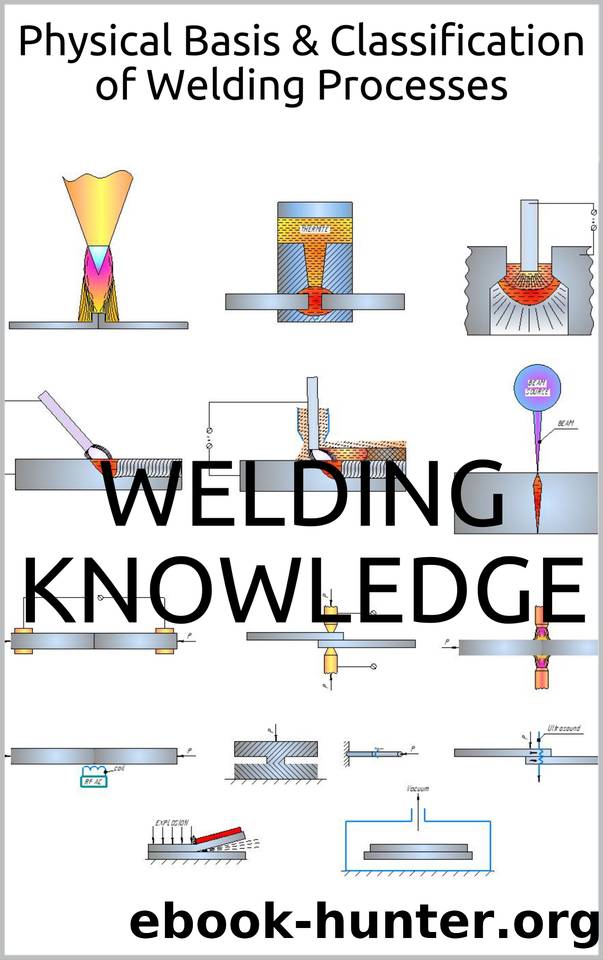Physical Basis & Classification of Welding Processes by Welding Knowledge

Author:Welding Knowledge [Knowledge, Welding]
Language: eng
Format: azw3, epub
Publisher: UNKNOWN
Published: 2020-06-29T16:00:00+00:00
The substance may be administered with a consumable electrode or as an additive. In pressure welding, mainly only deformation, diffusion and structural transformations of the substance occur. The analysis of mass transfer and substance transformations during welding processes is very complicated and is not included in the objectives of this book.
Classification of Welding Processes
When classifying welding processes, it is advisable to distinguish three main physical attributes: the presence of pressure, the form of the input energy, and the type of tool - the energy carrier. The remaining signs can be conditionally attributed to technical and technological. The pressure classification feature applies only to welding and soldering. By the energy introduced into the product, all welding processes, including welding, soldering, cutting, and others, can be divided into thermal, thermomechanical, mechanical, and special ones.
Thermal processes occur without pressure (fusion welding), the rest usually with pressure (pressure welding).
The terms class, method, type, method are conditional, but, having entered the classification, they allow in the future to maintain a clear typification system for welding processes. The term process is used as independent of classification groups.
We will touch upon the classification of welding methods by physical features. Physical attributes are common to all welding methods. Technical features can only be defined for individual welding methods.
Pressure-free welding by fusion is a thermal process: gas welding, thermite welding, arc welding, induction welding, electron beam welding, laser welding, plasma welding.
Pressure welding is a thermomechanical and mechanical process. Thermomechanical processes: resistance welding, gas-pressure welding, induction pressure welding, arc-pressure welding, pressure furnace, thermite pressure welding, thermo-compression welding, diffusion welding. Mechanical processes: cold welding, friction welding, ultrasonic welding, explosion welding, vacuum setting welding.
Energy analysis shows that all currently known metal welding processes are carried out by introducing only two types of energy - thermal and mechanical, or a combination thereof. Therefore, so far only neutron welding and conditionally bonding can be included in the group of special processes, which practically occurs without the introduction of energy. Vacuum setting welding is possible only in the presence of compression, therefore, it is also referred to mechanical processes, although during welding here energy can even be released, and not introduced from outside.
The term pressure welding, which has developed over the years, is not entirely accurate, since pressure in these processes is not the only source of external influence. Pressure is always necessary when there is no molten metal bath during welding, and the approach of atoms is achieved due to the elastic-plastic deformation of the surface material. Therefore, pressure usually determines at what phase state the material is connected.
It should be noted that even in the presence of pressure, metal can melt, for example, during thermite welding with pressure, spot and seam welding with the formation of a cast core, flash butt welding, friction welding, etc.
It is highly desirable that the order of the processes in the classification be determined by any quantitative technical and economic features. Such signs may be the values of specific energies, welding, or introduced into the product, specific costs for welding.
Download
Physical Basis & Classification of Welding Processes by Welding Knowledge.epub
This site does not store any files on its server. We only index and link to content provided by other sites. Please contact the content providers to delete copyright contents if any and email us, we'll remove relevant links or contents immediately.
Whiskies Galore by Ian Buxton(41524)
Introduction to Aircraft Design (Cambridge Aerospace Series) by John P. Fielding(32883)
Small Unmanned Fixed-wing Aircraft Design by Andrew J. Keane Andras Sobester James P. Scanlan & András Sóbester & James P. Scanlan(32569)
Craft Beer for the Homebrewer by Michael Agnew(17927)
Turbulence by E. J. Noyes(7690)
The Complete Stick Figure Physics Tutorials by Allen Sarah(7135)
Kaplan MCAT General Chemistry Review by Kaplan(6589)
The Thirst by Nesbo Jo(6432)
Bad Blood by John Carreyrou(6271)
Modelling of Convective Heat and Mass Transfer in Rotating Flows by Igor V. Shevchuk(6219)
Learning SQL by Alan Beaulieu(6029)
Weapons of Math Destruction by Cathy O'Neil(5822)
Man-made Catastrophes and Risk Information Concealment by Dmitry Chernov & Didier Sornette(5641)
Digital Minimalism by Cal Newport;(5388)
Life 3.0: Being Human in the Age of Artificial Intelligence by Tegmark Max(5182)
iGen by Jean M. Twenge(5155)
Secrets of Antigravity Propulsion: Tesla, UFOs, and Classified Aerospace Technology by Ph.D. Paul A. Laviolette(4974)
Design of Trajectory Optimization Approach for Space Maneuver Vehicle Skip Entry Problems by Runqi Chai & Al Savvaris & Antonios Tsourdos & Senchun Chai(4837)
Electronic Devices & Circuits by Jacob Millman & Christos C. Halkias(4739)
